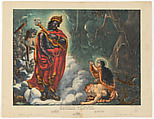Savitri
Not on view
The legendary princess Savitri embodies the Brahmanical vision of the ideal wife’s unstinting devotion to the welfare of her husband. It is first told in the Mahabhatata that Savitri, rejecting many royal suitors, resolves to marry the poor forest dweller Satyavann, a man of high moral virtue, who has devoted his life to caring for his blind parents. When Satyavann’s health fails and Yama, god of death appears to take his soul, Savitri pleads with Yama to spare him. Yama is so moved by the wife’ piety—and her courage in challenging him—that he grants her wish, and as a boon, restores Satyavann’s parents’ eyesight as well. The artist has chosen the moment of boon granting by Yama to represent this story. The supine figure of Satyavann lies at Savitri’s side, deep in the forest awaiting death. Savitri’s hands are raised in supplication to the mighty presence that is Yama, crowned and clad in a crimson robe and wielding a bejeweled golden mace (gada) as he descends on billowing white clouds, radiant in his power. A horde of the ghostly dead wait impatiently behind him to do his bidding. In the shadows behind Savitri is the firewood they had gathered, broken and mangled like bones on a charnel ground. The theatricality of the scene is worthy of a moment from a staged production of King Lear.
This image cannot be enlarged, viewed at full screen, or downloaded.

